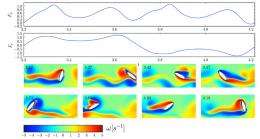To flap, or not to flap? Flapping wings can be more efficient than fixed wings, study shows

(PhysOrg.com) -- According to a new Cornell study, an optimized flapping wing could actually require 27 percent less power than its optimal steady-flight counterpart at small scales.
In the search for better ways to fly, researchers have long pondered the question: Which is a better system -- the flapping wings of birds and insects, or the fixed wings of your average 747?
The answer depends on a host of variables, including the size of the object and the type of flight. If maneuverability is the goal, birds and insects seem to have the advantage. When it comes to efficiency, most aeronautical engineers would agree that the fixed-wing airplane is the smartest design.
But according to a new Cornell study, an optimized flapping wing could actually require 27 percent less power than its optimal steady-flight counterpart at small scales.
The study, by Jane Wang, professor of theoretical and applied mechanics, and graduate student Umberto Pesavento, is published in the Sept. 11 issue of Physical Review Letters (103:11).
To find an optimum combination of motion and wing orientation, the researchers analyzed the interactions between a wing and its aerodynamic wake in two dimensions for a group of flapping motions with characteristics similar to those observed in hovering insects, using fruit fly wing dimensions as a model.
Doing such calculations for systems in three dimensions would require many dozens of hours per trial on most computers, which would make it impossible to find an optimum among infinite possibilities, Wang said.
"We wanted to include as much as possible so we don't miss the good solutions, but we can't include everything because it would be impossible," Wang said.
For the fixed-wing scenario, the optimum occurs at a specific angle of attack. Therefore, at first glance, flapping flight would seem less efficient because the wing would necessarily deviate from the optimum condition.
Building on Wang's previous work studying insect flight, the researchers constructed a special family of wing motions that allowed them to optimize a range of parameters, including optimum angle of attack, turning speed, frequency and timing between pitching and flapping for a wing of the same size and with the same amount of weight to support.
The most efficient flapping motion, they found, required significantly less power than the corresponding fixed-wing motion. Unlike a simple sinusoidal, or symmetrical up-and-down flapping motion, which is more commonly studied but much less efficient, the optimized motion holds the wing's angle of attack steady for a longer time near the optimum angle for its fixed counterpart; and also takes advantage of air patterns created as it reverses direction.
The discovery of one instance in which flapping is more efficient than steady flight, Wang said, shows that our intuition about flight efficiency isn't always right, especially when unsteady aerodynamics is at play.
At a more practical level, the study shows the possibility of substantially improving design of flapping flight, which typically has low efficiency, using a trial-and-error approach. "The trial-and-error approach is particularly ineffective for these problems, where poor solutions dominate the landscape and good solutions are few," Wang said.
Provided by Cornell University (news : web)

















